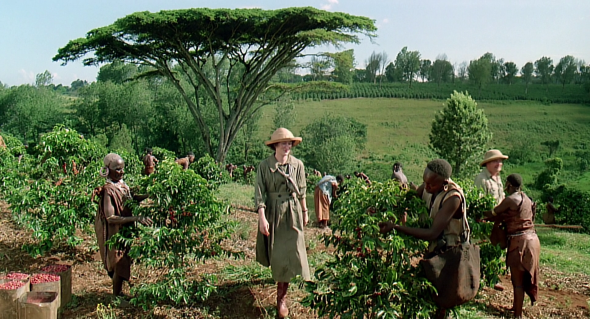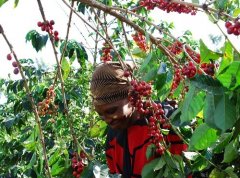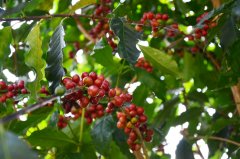What is the difference between the AA Sika production area in Kenya and the Gachatha processing plant in Nyeri, Kenya?
What is the difference between the AA Sika production area in Kenya and the Gachatha processing plant in Nyeri, Kenya?

Gachatha Gachasha producing area
Ichamama Wet Mill is located in the Othaya Farmers Cooperative in Karuthi District, 1800masl High Nyrei City.
In addition to growing coffee, there are also tea in this area. Coffee beans are mainly SL28,SL34, a small amount of Ruiru 11, Batian, Geisha and the main AA grade. In the kenya raw bean rating, they will take the size as the grade, and AA,AB,PB is the most common (and AA is the largest size-7-8mm). Farmers will pick out the unripe or overripe fruit after harvest, and then take the ripe fruit for treatment. The peas will be divided into three classes according to the density of the coffee. 1 and 2 will ferment together, but the lower Grade 3 will not be used. The coffee beans will ferment in the shade for 16-24 hours. After fermentation, the coffee beans will be washed and re-graded in Washed channel. Finally, the beans will be soaked in clean water from the Gatomoboya River for 16-18 hours, and the coffee beans will be dried on the African scaffolding for at least 21 days. At noon and at night, farmers would cover their coffee beans with cloth to keep them from overdrying.
Kiambu, Kirinyaga, Nyeri,Thika
These four producing areas can be regarded as the more famous producing areas of Kenya, while most of the producing areas are above 1300masl, and the beans planted are mainly varieties of Bourbon, such as French mission, the very famous SL28,SL34, with the deterioration of the environment and climate, the disease resistance of coffee is getting worse and worse, and the mixed-race beans studied by Ruiru 11 (Hibrido de Timor) finally have great uses, but it is a pity that cup profile is not as rich as SL28,SL34. So Kenya Coffee Research Institute (CRI) has been studying new varieties: Batian,Batian is named after the highest peak of Mount Kenya. It was announced as early as 2010 that the flavor and disease resistance of the plant were better than those of the SL series, but there were not too many people (mainly small holder) planted at that time, so there was not much discussion. It was not until the 16-17 season, when more and more farmers got the ideal flavor and harvest of batian, that batian became popular in the market. (at that time, World brewers cup runner-up MIKAELA won the award for using kenya beans and once again set off a global discussion about kenya as a producing country.) Having said that, it is difficult to find pure batian beans on the market, because generally washing plants mix different beans into different batches for sale. (ALEX, the store manager, is also planning a bean-hunting trip to Kenya next year.) in recent years, the Kenyan coffee market is mainly faced with the problem of production reduction, while the output is reduced while its quality is not as good as before, the flavors that can be drunk are generally (tomato, raisins). Some Rwanda and Burundi also have similar flavors rather than sensational (blackcurrant, libina, changeable berries) flavors, so they haven't purchased kenya for a long time. Until early September, when we blindly tested kenya samples, one of them was found to have (floral, blackcurrant, BlackBerry, maple syrup), while the others were good (blueberry, caramel, raisin). Looking through the data, I learned that this coffee mixed with a small amount of geisha and batian, and decided to purchase it after consideration. Traditionally, Kenyan coffee is exported in 60kg a sack, but some of the better and fewer batches are packed in 30kg vacuum. This is the case with Ichamama. In roasting techniques, a new idea is used to bring out the flavor of beans more completely. In sample roasting (sample baking), we found that the flavor (flower, orange, sucrose) can be obtained at a shallow baking degree, but the acidity is not bright and Aftertaste is not sweet. Then it is obtained from the usual medium baking (blackcurrant, grapefruit, chocolate milk chocolate), although the acidity and sweetness are increased, but not lightly baked.
After baking many times, the following conclusions are drawn:
Reduce the usual amount of baked beans to (one-third), and it is also usually adjusted faster on Drum speed (relatively fast speed), so in the use of hot air convection with higher hot air and furnace temperature, and bake beans in the future, let beans enter the yellow stage ahead of time. After entering the yellow stage, you will slow down the speed, lengthen the rhythm of the middle and back section, enhance the taste and sweetness, and finally adjust to a low heat when it is close to an explosion. The stir-fry ends when it is in the middle of the fry
The results are as follows:
Although the taste belongs to medium light, the sweetness and flavor of the aroma are just right, and the flavors of blackcurrant and Ribina are very significant, and the flavor of beans will be improved for about a week.
Asali Asaria producing area
Honey cooperative Asali, belongs to the large particle AA batch, shallow roasted bright fruit acid will make your taste buds stunning, medium and deep roasted caramel spices sweet can also satisfy heavy taste gluttons, honey cooperative currently has 155members, the coffee growing area is in the foothills of Alberdeli Aberdare, 1650 SL28 1800m above sea level, coffee varieties include SL28 and SL34, farmers pick fully ripe coffee cherries by hand in March On the same day, it was sent to the treatment plant for peeling, water washing and fermentation, and then picked up and placed in an African scaffolding to dry. It will be turned manually several times a day to remove defective beans and ensure uniform drying!
The dry aroma of shallow baking is sweet and honey, with a hint of elegant flowers and sweet and sour peaches, while the wet aroma turns to bright cranberries, plums and blackcurrants, with sweet and sour black sugar. the taste is sour and sweet, such as plum, citrus and cranberry fruit juice. the sweet and sour black sugar is also suitable, and the coffee shows the sour and sweet of California plum when the coffee temperature is cooler, and there is also a hint of red wine. The medium and deep baked dry aroma has strong caramel sweet with cocoa and Chinese fir essential oil, wet caramel sweet, Chinese fir with a hint of brandy, thick and thick taste, caramel sweet with dried litchi, some spices and brandy, dried lychee and dried cranberry sweet after the temperature drop, and bitter sweet Chinese fir and chocolate in the remaining rhyme.
Important Notice :
前街咖啡 FrontStreet Coffee has moved to new addredd:
FrontStreet Coffee Address: 315,Donghua East Road,GuangZhou
Tel:020 38364473
- Prev

What is the flavor and taste of coffee from Gachatha Gachasha processing Plant in Nyeri, Kenya?
Introduction to coffee flavor and taste of Gachatha Gachasha processing Plant in Nyeri, Kenya describes Kenya as a country that produces fine coffee. Only the traditional Arabica was introduced from Britain in 1900, and it was not until 1950 that the best bourbon varieties of SL28 and SL34 in Kenya appeared. Most of the coffee beans are graded by the Kenya Coffee Bureau and then at the auction.
- Next

Ethiopian Sun-Treated Faye Garberry Orchard/Polyphine G1 Flavor Trend
Ethiopian Sun-treated Faye Sherry Orchard/Polyphine G1 Flavor Trend Flavor Description: Intense berry and fruit dry aromas, strong strawberry, blueberry with passion fruit, mango and other tropical fruit aromas at the beginning of the drink, apricot, peach and grape juice flavors in the middle, floral, peach and berry aromas throughout the taste buds, firm and juicy flavors
Related
- Detailed explanation of Jadeite planting Land in Panamanian Jadeite Manor introduction to the grading system of Jadeite competitive bidding, Red bid, Green bid and Rose Summer
- Story of Coffee planting in Brenka region of Costa Rica Stonehenge Manor anaerobic heavy honey treatment of flavor mouth
- What's on the barrel of Blue Mountain Coffee beans?
- Can American coffee also pull flowers? How to use hot American style to pull out a good-looking pattern?
- Can you make a cold extract with coffee beans? What is the right proportion for cold-extracted coffee formula?
- Indonesian PWN Gold Mandrine Coffee Origin Features Flavor How to Chong? Mandolin coffee is American.
- A brief introduction to the flavor characteristics of Brazilian yellow bourbon coffee beans
- What is the effect of different water quality on the flavor of cold-extracted coffee? What kind of water is best for brewing coffee?
- Why do you think of Rose Summer whenever you mention Panamanian coffee?
- Introduction to the characteristics of authentic blue mountain coffee bean producing areas? What is the CIB Coffee Authority in Jamaica?

